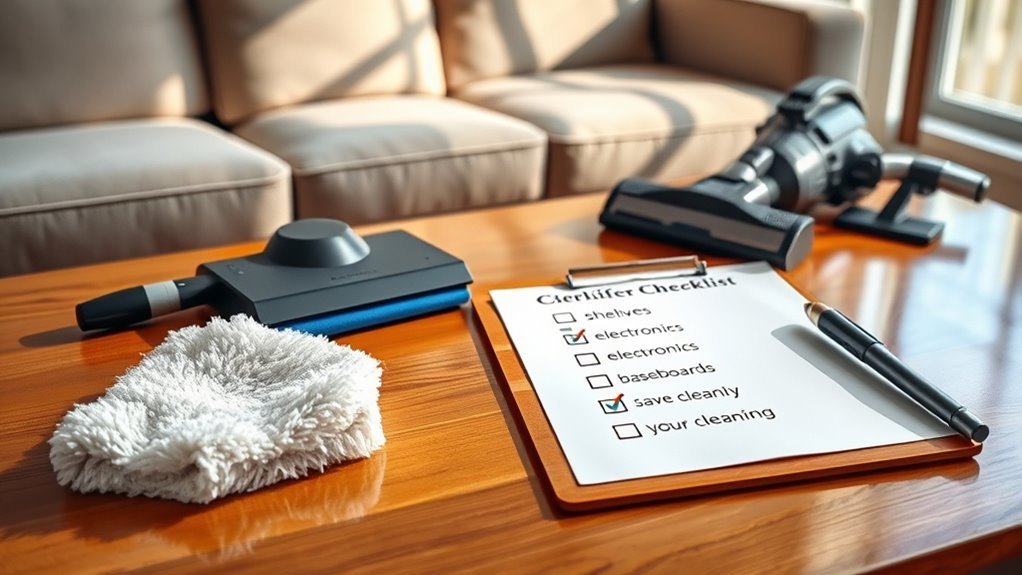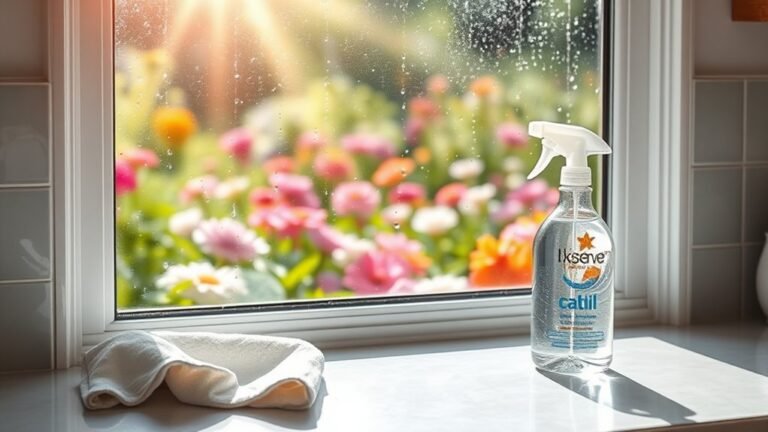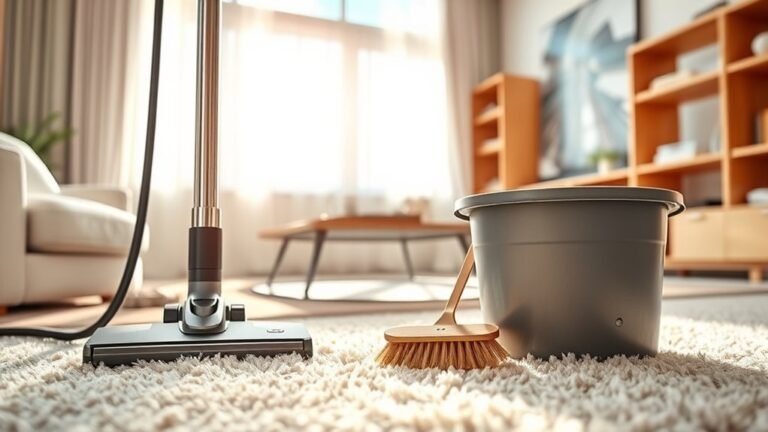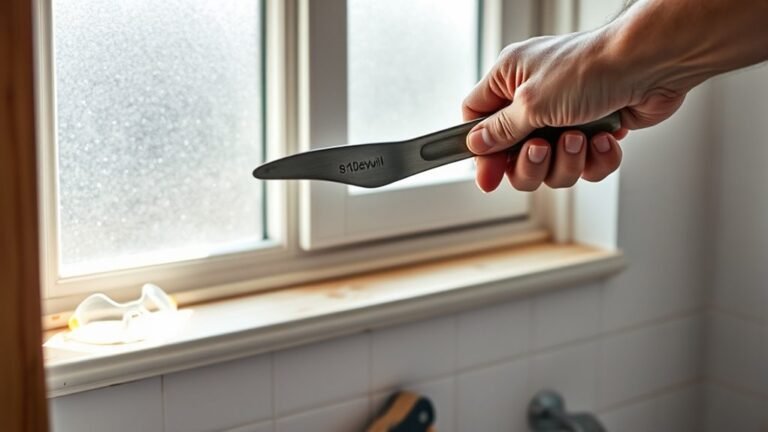Deep Cleaning Checklist for Dust
To deep clean dust effectively, use microfiber cloths and electrostatic dusters tailored to surfaces—slightly damp for wood, dry for glass, gentle for metal. Unplug and carefully wipe electronics, focusing on vents. Don’t skip upholstery—vacuum regularly and treat fabrics per instructions. Target hard-to-reach corners with narrow brushes and extendable dusters. Manage bedroom, living, and kitchen dust with organized decluttering and routine cleaning. Proper floor care and air filter maintenance round out control. Detailed strategies can guarantee thorough dust removal throughout your space.
Dusting Techniques for Different Surfaces

Although dusting might seem straightforward, using the right technique for each surface is essential to avoid damage and guarantee thorough cleaning. You need to take into account the furniture materials—wood, glass, metal, or fabric—since each requires a specific approach. For example, use a microfiber cloth dampened slightly for wood to prevent scratches, while a dry, soft cloth suits glass surfaces to avoid streaks. Metal surfaces benefit from gentle polishing after dusting. Adjust your dusting frequency based on exposure and material sensitivity; wooden furniture might need weekly dusting, whereas less exposed surfaces can be addressed biweekly. By tailoring your technique and schedule to the furniture materials, you’ll maintain their integrity and appearance, ensuring your environment stays clean without compromising your freedom to enjoy your space.
Essential Tools for Effective Dusting
Effective dusting relies heavily on using the right tools tailored to different surfaces and dust types. You’ll want to select dusting products designed to capture and hold dust rather than merely push it around. Microfiber cloths are indispensable for their electrostatic properties, trapping fine particles effectively. Extendable dusters reach high or awkward spots, freeing you from ladders. For delicate surfaces, soft-bristled brushes prevent scratches while dislodging dust gently. Cleaning gadgets like vacuum attachments with brush tips enhance thoroughness, especially in tight corners. Using the appropriate tool guarantees efficient dust removal, reducing allergens and maintaining surface integrity. By equipping yourself with these precise dusting products and gadgets, you gain control over your environment, enabling a deeper, more liberating clean without unnecessary effort or chemical reliance.
Dusting Electronics and Appliances Safely

When dusting electronics and appliances, you need to prioritize safety to prevent damage and maintain functionality. Start by unplugging devices to eliminate electrical risks. Use a microfiber cloth or an electrostatic duster designed for safe cleaning to avoid static buildup that can harm sensitive components. Avoid spraying liquids directly onto surfaces; instead, lightly dampen the cloth with a 50/50 mix of distilled water and isopropyl alcohol for effective dust removal without residue. Pay close attention to vents and crevices, where dust accumulates and can impair appliance performance. Gentle, consistent pressure prevents scratching and dislodging internal parts. Following these steps guarantees thorough appliance care, extending device lifespan while providing you the freedom to maintain a clean, dust-free environment without compromising safety or functionality.
How to Dust Upholstery and Soft Furnishings
A crucial step in maintaining upholstery and soft furnishings is removing dust without damaging delicate fabrics. Begin with upholstery vacuuming, using a brush attachment to gently lift dust from surfaces without abrasion. Adjust suction power to avoid fabric distortion. For fabric protection, test any cleaning tool or product on a hidden area first. Regular vacuuming prevents dust accumulation, which can degrade fibers over time. Avoid excessive moisture; instead, lightly dampen a microfiber cloth when wiping is necessary. Pay close attention to seams and crevices where dust settles. Prioritize materials’ care labels and manufacturer instructions to preserve texture and appearance. By following these precise steps, you maintain the integrity of your soft furnishings while effectively controlling dust, granting you freedom from allergens and prolonging your furniture’s lifespan.
Cleaning Hard-to-Reach Areas and Corners

You’ll need specialized tools like narrow brushes and flexible dusters to access tight spaces effectively. Using precise dust removal techniques guarantees you eliminate debris without spreading it elsewhere. Regular attention to these spots helps prevent dust buildup and maintains overall cleanliness.
Tools for Tight Spaces
Although tight spaces often pose challenges during deep cleaning, utilizing specialized tools can greatly improve access and effectiveness. Microfiber tools are essential; their fine fibers trap dust without dispersing particles, making them efficient for confined areas. You’ll find flexible microfiber dusters ideal for reaching narrow gaps, vents, and behind appliances. Corner brushes, designed with angled bristles, excel at dislodging dust from sharp corners and crevices where standard tools fail. Their compact size allows you to maneuver easily into tight spots, ensuring thorough cleaning. Combining these tools lets you maintain control and precision while freeing yourself from the constraints of inaccessible areas. Investing in quality microfiber tools and corner brushes is critical to mastering deep cleaning in hard-to-reach locations, ultimately enhancing your environment’s cleanliness and your freedom to maintain it.
Effective Dust Removal Techniques
Mastering effective dust removal techniques requires more than just having the right tools for tight spaces; it involves applying methods that maximize their efficiency. When tackling hard-to-reach areas and corners, use extendable microfiber dusters designed for eco friendly dusting—they trap dust without chemicals, preserving air quality. Prioritize a top-down approach, starting from ceiling fans and vents, moving downward to baseboards and floor edges to prevent recontamination. During seasonal cleaning, employ compressed air or vacuum attachments with narrow nozzles to dislodge dust from crevices. Combine gentle agitation with static charge reduction by lightly misting microfiber cloths, enhancing dust capture. Consistently rotating these methods frees your space from buildup while maintaining environmental responsibility, ensuring thorough and sustainable dust removal.
Preventing Dust Accumulation
How can you effectively prevent dust buildup in the often overlooked corners and tight spaces of your home? Start by integrating targeted dust prevention practices such as using extendable microfiber dusters designed to reach narrow areas. Regularly vacuum with attachments engineered for crevices to disrupt dust accumulation. Incorporate air filtration systems with HEPA filters to reduce airborne dust particles, minimizing deposition on surfaces. Seal gaps and cracks where dust tends to settle, and maintain consistent cleaning schedules focusing on these hard-to-reach zones. Additionally, controlling indoor humidity between 40-50% can reduce static that attracts dust. By combining precise mechanical cleaning tools with environmental controls like air filtration systems, you’ll greatly limit dust buildup in corners and confined spaces, promoting a cleaner, freer living environment without excessive effort.
Managing Dust in Bedrooms and Closets
One of the most effective ways to manage dust in bedrooms and closets is to establish a routine that targets common accumulation points such as shelves, baseboards, and fabric surfaces. Prioritize bedroom organization to reduce clutter, making dusting more efficient. Guarantee closet ventilation is adequate to minimize stagnant air where dust settles.
| Area | Action Required | Benefit |
|---|---|---|
| Shelves | Wipe with microfiber cloth | Removes settled dust |
| Baseboards | Vacuum and wipe regularly | Prevents dust buildup |
| Fabric surfaces | Use lint rollers or vacuum | Captures dust trapped in fibers |
| Closet air space | Improve ventilation | Reduces airborne dust |
Consistently following this plan helps you reclaim your space, promoting freedom from allergens and maintaining a cleaner environment.
Strategies for Dusting Living Rooms and Common Areas
Because living rooms and common areas experience high traffic and diverse surfaces, dusting strategies must be tailored to address varied materials and frequent use. Start by decluttering to optimize living room organization, allowing access to all surfaces. Use microfiber cloths or electrostatic dusters to capture dust without dispersing it. For upholstery, vacuum with appropriate attachments to remove embedded particles efficiently. Focus on high-touch areas like light switches, shelves, and electronics, applying gentle cleaning agents compatible with each material. Incorporate a consistent schedule into your common area maintenance routine to prevent buildup and maintain air quality. Don’t forget to dust ceiling fans and vents, as they circulate dust throughout the space. By applying these precise methods, you’ll maintain a cleaner, healthier living environment that supports your freedom to enjoy these shared spaces fully.
Dust Control in Kitchens and Dining Spaces
Kitchens and dining spaces require targeted dust control measures due to their unique combination of food preparation surfaces, appliances, and dining furniture. Efficient dust control here helps maintain hygiene and preserves the aesthetic integrity of your dining decor. You’ll want to focus on:
- Ensuring ideal kitchen ventilation to reduce airborne dust and cooking residues that settle on surfaces.
- Regularly wiping down appliances and countertops with microfiber cloths to trap fine dust without redistributing it.
- Maintaining dining furniture and decor by dusting with appropriate tools to prevent buildup in crevices and fabric.
Maintaining Dust-Free Floors and Carpets
Maintaining dust-free floors and carpets requires a systematic approach that combines regular cleaning techniques with appropriate tools. You should start with consistent floor cleaning using a vacuum equipped with a HEPA filter to efficiently capture fine dust particles. For hard floors, use a microfiber mop dampened with a mild detergent solution to trap dust instead of dispersing it. Carpet maintenance demands periodic deep cleaning, such as steam cleaning, to remove embedded dust and allergens beyond surface vacuuming. Additionally, address high-traffic areas more frequently to prevent dust accumulation. Implementing door mats and removing shoes indoors minimizes dirt introduction, enhancing dust control. By integrating these targeted strategies, you’ll guarantee cleaner floors and carpets, contributing to a healthier indoor environment and greater freedom from airborne irritants.
Frequently Asked Questions
How Often Should I Schedule a Deep Dust Cleaning?
You should establish a weekly schedule for routine dusting to maintain ideal air quality and cleanliness. However, for a thorough deep dust cleaning, adjusting the cleaning frequency to every three to six months is advisable, depending on your environment and lifestyle. This approach balances efficiency with freedom, ensuring your space stays fresh without overwhelming your routine. Regular assessment lets you tailor the frequency, keeping dust levels under control effectively.
Can Air Purifiers Reduce Household Dust Effectively?
Absolutely, air purifiers provide powerful particle purification, promoting profound dust particle reduction. Their air purifier effectiveness hinges on high-efficiency particulate air (HEPA) filters that capture microscopic dust particles, allergens, and pollutants. By continuously cycling indoor air, they considerably decrease airborne dust, offering you freedom from frequent dusting and improved air quality. However, for best results, combine purifiers with regular cleaning routines, as purifiers alone can’t eliminate settled dust on surfaces.
What Are Common Allergens Found in Household Dust?
Common allergens found in household dust include dust mites and pollen sources. Dust mites thrive in warm, humid environments, feeding on dead skin cells, while pollen enters your home through windows, doors, and on clothing. These allergens can trigger respiratory issues and allergic reactions. To maintain a healthier living space and enjoy freedom from irritation, you’ll want to minimize exposure by controlling humidity, regularly cleaning, and using air purifiers designed to capture these microscopic particles.
Does Humidity Affect Dust Accumulation?
Yes, humidity levels directly affect dust accumulation. When humidity rises above 50%, dust mites thrive because they need moisture to survive. This boosts dust mite populations, increasing allergens in your home. Conversely, lower humidity levels inhibit their growth but can cause dust to become more airborne, making it easier to inhale. Managing humidity around 40-50% helps control dust mites and reduces overall dust accumulation, giving you a healthier living space.
Are There Natural Remedies to Prevent Dust Buildup?
You can use natural solutions for dust prevention effectively. Essential oils like eucalyptus or tea tree, when diffused, can reduce airborne dust particles. Houseplants such as spider plants and peace lilies act as natural air purifiers, capturing dust. Regularly wiping surfaces with a microfiber cloth dampened with vinegar and water also helps. These methods offer precise, chemical-free dust control, letting you maintain a cleaner environment without sacrificing your freedom from harsh cleaners.






